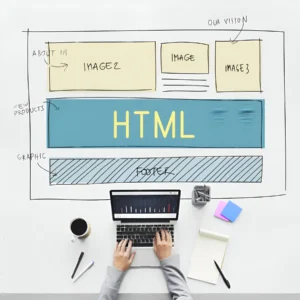“`html
Introduction to HTML Language
HTML is the fundamental language used in designing and building web pages. It was first developed in the early 1990s by Tim Berners-Lee, the British scientist who invented the World Wide Web. Since then, HTML has become the backbone of the web, where it’s used to define the structure of content on web pages.

HTML is not a programming language in the traditional sense, but rather a markup language used to organize different elements on a web page such as text, images, links, tables, and other elements. The code is written using HTML tags, which are words enclosed in angle brackets < >. These tags instruct the browser on how to display the content.
The Importance of HTML in Web Development
HTML is the foundation that all developers rely on when building websites. Without HTML, there would be no way to display content on the internet. Below are some reasons why HTML is essential:
- Ease of Learning and Use: One of the biggest advantages of HTML is that it’s easy to learn, even for beginners. You don’t need a strong technical background to understand how it works.
- Browser Compatibility: All major browsers (such as Google Chrome, Firefox, Safari) support HTML, meaning web pages built with it will appear correctly on any device.
- Integration with Other Technologies: HTML seamlessly integrates with other programming languages like CSS and JavaScript. While HTML defines the basic structure of the page, CSS can be used to customize design and layout, and JavaScript adds interactivity.
- Search Engine Optimization (SEO): HTML plays an important role in improving your site’s visibility on search engines like Google. By organizing content using proper HTML tags (such as
<title>,<meta>,<header>, and<footer>), you can improve your site’s ranking in search results.
The Basic Structure of an HTML Document
To create a web page using HTML, you need to have a clear understanding of the basic structure of the document. Any HTML document consists of a set of elements that start with the <html> tag and end with the </html> tag. Here is a simplified explanation of the basic structure:
<html>
<head>
<title>Page Title</title>
</head>
<body>
<h1>Hello World!</h1>
<p>This is the first paragraph on my page.</p>
</body>
</html>
Structure Explanation:
<!DOCTYPE html>: Specifies the document type and tells the browser that this is an HTML5 document.<html>: The main element that contains all other elements.<head>: Contains metadata such as the title and description.<title>: Sets the page title displayed in the browser tab.<body>: Contains the actual content displayed on the page.
Common Tags in HTML
HTML includes many tags that are used to define different types of content. Below is a list of some of the most commonly used tags:
| Tag | Function |
|---|---|
<h1> to <h6> |
Define headings with different sizes, where <h1> is the largest and <h6> is the smallest. |
<p> |
Defines a paragraph of text. |
<a> |
Creates hyperlinks. |
<img> |
Inserts images into the page. |
<ul> and <ol> |
Create unordered (ul) and ordered (ol) lists. |
<table> |
Creates data tables. |
<div> |
Defines blocks of content to organize the page. |
<form> |
Creates input forms. |
Creating Tables in HTML
One of the most common uses of HTML is creating data tables. Tables are used to present information in an organized and readable format. A table is created using the following tags:
<table>: Defines the table.<tr>: Defines a row within the table.<th>: Defines a column header.<td>: Defines a cell containing data.
Example of a Simple Table:
<table border=”1″>
<tr>
<th>Student Name</th>
<th>Grade</th>
</tr>
<tr>
<td>Mohammad</td>
<td>90</td>
</tr>
<tr>
<td>Fatima</td>
<td>85</td>
</tr>
</table>
Search Engine Optimization (SEO) Using HTML
One of the most important reasons why HTML is essential is its role in Search Engine Optimization (SEO). By using the correct tags, you can improve your site’s ranking in search results. Below are some tips for optimizing SEO using HTML:
- Using Appropriate Heading Tags: Use
<h1>for the main heading,<h2>for subheadings, and so on. This helps search engines understand the structure of the page. - Adding Page Description (Meta Description): Use the
<meta>tag to describe the page content.html1<meta name=“description” content=“This website discusses the basics of HTML”> - Organizing Images Using Alt Text: Use the
altattribute to describe images, helping search engines understand their content.html1<img src=“logo.png” alt=“Website logo”> - Creating Internal and External Links: Use the
<a>tag to create links that contribute to improving the page’s ranking.
The Future of HTML
As technology evolves, HTML continues to evolve as well. The current version, HTML5, introduces many new features that make web development more efficient and easier. Some of these features include:
- Video and Audio Support: You can now embed video and audio clips directly into the page without needing additional plugins.
- New APIs: HTML5 gives you access to device functions such as the camera, GPS, and more.
- Performance Improvements: HTML5 is faster and more efficient compared to previous versions.
Conclusion
The HTML language is the foundation upon which the web is built. Without it, there would be no way to display the digital content we use daily. By understanding how HTML works and using it correctly, you can begin your journey into the world of web development. Whether you’re a professional developer or just a beginner, learning HTML is a fundamental step toward mastering this field.
Ultimately, it can be said that HTML is not just a programming language, but a powerful tool that allows us to build and organize content effectively. If you want to enter the world of web development, there is no doubt that HTML is the ideal starting point.
“`
 العربية
العربية

